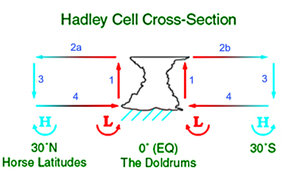Hadley cell
|
|
The major driving force of atmospheric circulation in the tropical regions is solar heating. Because of the Earth's 23.5 ° axial tilt, the sun is never more than a few tens of degrees from directly overhead at noon in the tropics; as a consequence, incident solar radiation provides maximum energy at the equator. This heat is largely transported into the atmosphere as latent heat via convection in daily thunderstorms that form in this weather belt.
In the early 1700s, George Hadley, an English lawyer and amateur meteorologist, set out to determine what it was that caused the Northern-hemisphere trade winds to blow west instead of straight south. Edmond Halley, the astronomer noted for the comet bearing his name, had some years earlier proposed a theory of circulation which would result in trade winds, but which could not take into account their change in direction. It was Hadley who realized that a rotating coordinate system would be required to describe the motions of the winds, and hence, that Gaspard-Gustave Coriolis work in producing the necessary equations would be germane to his own work. And so it was that the necessary critical link was added which resulted in Hadleys description of the equatorial zone circulation cell, which is known today as the Hadley cell.
The Hadley cell is a closed circulation cell. At (1), warm, moisture-bearing air converges at the equator. Because the Coriolis force is negligible within about five degrees either side of the geographic equator, winds are light and capricious in direction. The primary movement of air is upward, and thunderstorms are prime transporters of moisture and heat to the upper troposphere. These air masses eventually reach the tropopause, the boundary between the troposphere and the stratosphere, at a height of between 12 and 15 km, and cannot proceed upward. Nor, because of the upward-welling air below them, can they sink. As a consequence, they are forced either north (a) or south (b) of the equator (2a, 2b).
It is at this point the Coriolis force evidences itself, leading to a clockwise rotation in the northern hemisphere and a counterclockwise rotation on the southern hemisphere.
The airflow loses heat as it travels, and at about 30° north/south of the equator, it begins to descend (3). As it descends it is compressed, increases in temperature from adiabatic heating and thus the relative humidity decreases, so skies in this high-pressure weather regime tend to be cloud-free, and windless days are common.
This region marks the zone of separation between the Hadley cell and the temperate zone Ferrel cell, and is known as the "horse latitudes". According to the story, in times when ship's captains relied upon the wind to reach their destinations, finding themselves becalmed was usually bad news for any horses aboard, which were thrown overboard in order to conserve precious water.
At about 2 km above the surface of the Earth, the subsiding air enters the boundary layer, a region of the atmosphere where winds are subject to the influence of surface topography. While the Coriolis force twists the downfalling air, the effect of the friction layer is to contribute to this rotational effect. As well, the speed of the wind is affected by the terrain over which it passes - winds blow more strongly over grasslands and ocean than they do over forests and foothills. It is likewise in this layer that such localized and regionally peculiar atmospheric phenomena as lenticular (lens-shaped) clouds and chinook winds occur.
The airmass spreads out over the surface of the Earth, moving in a westerly direction. It begins its journey back toward the equator, (4) closing the Hadley cell, and appears as the Trade Winds.
As with any idealized system, it is important to realize that it is precisely that. A Hadley cell is bound as much by the laws of chaos as by the laws of thermodynamics, and what is here today may be there, or somewhere else, tomorrow.

